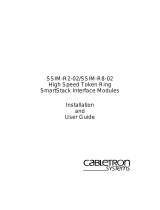Page is loading ...

1
Quick Start Guide
VirtualPort Software
For B092-016, B095-003-1E-M, B095-004-1E,
B096-016 and B096-048
1111 W. 35th Street, Chicago, IL 60609 USA
www.tripplite.com/support
Copyright © 2010 Tripp Lite. All rights reserved. All trademarks are the property of their respective owners.
Tripp Lite’s VirtualPort software delivers the virtual serial port technology your Windows
®
applications need to open remote serial ports and read the data from serial devices that are
connected to your console server.
VirtualPort works with all Tripp Lite Console Servers (the B096-016 / B096-048 Console
Server Management Switch, the B092-016 Console Server with PowerAlert and the B095-
003-1E-M / B095-004-1E Console Servers).
You are licensed to install VirtualPort on one or more computers for accessing any serial
device connected to any Tripp Lite Console Server port.
This Quick Start walks you through basic configuration. For more detail please refer to the
VirtualPort chapter in the User Manual on the CDROM.
201001081 93-2978.indd 1 2/1/2010 3:26:20 PM

2
VirtualPort for Windows
• The VirtualPort_setup.exe program is included on the CD supplied with your console
server. Double click to start installation.
• Clickthe VirtualPort icon on your desktop to start the client.
• ClickonAdd Ports and specify a name to identify the connection in the “Server
Description “ tab.
• Entertheconsole server’s IP address (or network name).
• EntertheServer TCP Port number that matches the port you have configured for the
serial device on the remote console server. Ensure this port isn’t blocked by firewall.
o Telnet RFC2217 mode is configured by default so the range of port numbers available
on a 16-port console server would be 5001-5016
o Alternately check RAW mode (4001- 4048 on a 48 port console server)
Note: Encrypted mode enables SSL/TLS encryption of the data going to the port and you
will need to enter a Password. This mode requires firmware 3.1 in the console server (which
will be available in Feb. 2010).
• SelectthestartingCOMport(COM1toCOM4096)andthenumberofportstobeadded
(sequential port numbers will be assigned automatically). Click OK.
Configuring a COM Port
• TocongureaCOMportsimplyclickonthedesiredCOMxlabel.
• YoucanthenconguretheCOMportinthe Connection and Advanced windows:
201001081 93-2978.indd 2 2/1/2010 3:26:21 PM

3
VirtualPort for Windows continued
Connection
• “Connect at system startup”—When enabled VirtualPort will try to connect to
the console server when the VirtualPort service starts (as opposed to waiting for the
application to open).
• “Time between connection retries” specifies the number of seconds between TCP
connection retries after a client-initiated connection failure. Valid values are 1-255. (The
default is 1000 milliseconds and VirtualPort will continue attempting to reconnect forever
to the console server at this interval.)
• The“Send keep-alive packets” option tests if the TCP connection is still up when
no data has been sent for a while by sending keep-alive messages. Select this option
and specify period of time (in milliseconds) after which VirtualPort sends a command
to remote console server end in order to verify connection’s integrity and keep the
connection alive.
• The“Keep-Alive Interval” specifies the number of seconds to wait on an idle connection
before sending a keep-alive message. The default is 1000 milliseconds. The “Keep-Alive
Timeout” specifies how long VirtualPort should wait for a keep-alive response before
timing out the connection.
Note: In the event of a “Keep-Alive Timeout”, ensure the remote serial device is connected
to the nominated port on your remote console server and the serial port has been
configured, i.e. set the RS232 Common Settings such as baud rate, select console server
mode for the port and specify the appropriate protocol to be used (RAW TCP, RFC2217 or
VirtualPort Secure mode for encrypted communication). Also ensure you can access the
console server.
• “Disable Nagle Algorithm”—The Nagle Algorithm is enabled by default and it reduces
the number of small packets sent by VirtualPort across the network.
Advanced
• Check“Receive DSR/DCD/CTS changes” if the flow control signal status from the
physical serial port on console server is to be reflected back to the Windows COM port
driver (as some serial communications applications prefer to run without any hardware
flow control i.e. in “two wire” mode).
201001081 93-2978.indd 3 2/1/2010 3:26:21 PM

4
Tripp Lite follows a policy of continuous improvement. Product specifications are subject to change without notice.
1111 W. 35th Street, Chicago, IL 60609 USA
www.tripplite.com/support
201001081•932978-EN
• The“Propagate local port changes” allows complete serial device control by the
WindowsapplicationsoitoperatesexactlylikeadirectlyconnectedserialCOMport.
It provides a complete COM port interface between the attached serial device and the
network, providing hardware and software flow control. So the baud rate, etc. of the
remote serial port is controlled by the settings for that COM port on a Windows computer.
If not selected then the port serial configuration parameters are set on the console server.
- With the “Emulate Baud Rate” selected, VirtualPort will only send data out at the baud
rate configured by the local application using the COM port.
VirtualPort for Windows continued
201001081 93-2978.indd 4 2/1/2010 3:26:21 PM
/

